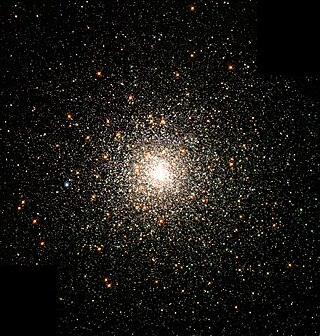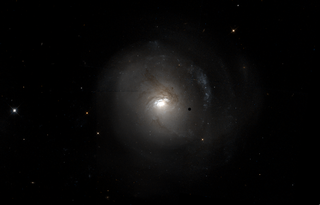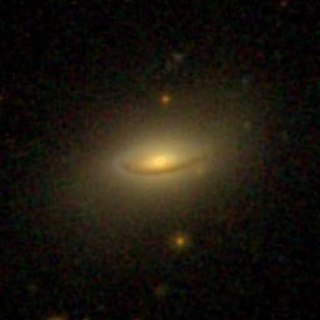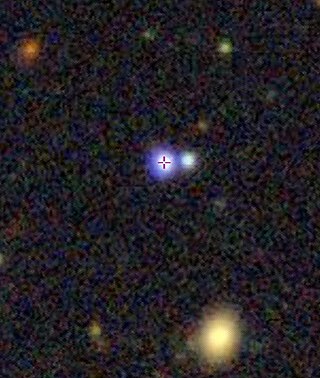Related Research Articles

The study of galaxy formation and evolution is concerned with the processes that formed a heterogeneous universe from a homogeneous beginning, the formation of the first galaxies, the way galaxies change over time, and the processes that have generated the variety of structures observed in nearby galaxies. Galaxy formation is hypothesized to occur from structure formation theories, as a result of tiny quantum fluctuations in the aftermath of the Big Bang. The simplest model in general agreement with observed phenomena is the Lambda-CDM model—that is, clustering and merging allows galaxies to accumulate mass, determining both their shape and structure. Hydrodynamics simulation, which simulates both baryons and dark matter, is widely used to study galaxy formation and evolution.

The Giant Metrewave Radio Telescope (GMRT), located near Narayangaon, Pune in India, is an array of thirty fully steerable parabolic radio telescopes of 45 metre diameter, observing at metre wavelengths. It is the largest and most sensitive radio telescope array in the world at low frequencies. It is operated by the National Centre for Radio Astrophysics (NCRA), a part of the Tata Institute of Fundamental Research, Mumbai. It was conceived and built under the direction of Govind Swarup during 1984 to 1996. It is an interferometric array with baselines of up to 25 kilometres (16 mi). It was recently upgraded with new receivers, after which it is also known as the upgraded Giant Metrewave Radio Telescope (uGMRT).

In astronomy, metallicity is the abundance of elements present in an object that are heavier than hydrogen and helium. Most of the normal currently detectable matter in the universe is either hydrogen or helium, and astronomers use the word "metals" as convenient shorthand for "all elements except hydrogen and helium". This word-use is distinct from the conventional chemical or physical definition of a metal as an electrically conducting solid. Stars and nebulae with relatively high abundances of heavier elements are called "metal-rich" in when discussing metallicity, even though many of those elements are called nonmetals in chemistry.
Guinevere Alice Mei-Ing Kauffmann was born in California. She is an astrophysicist and is known for her work studying galaxies among other subjects.

The Sérsic profile is a mathematical function that describes how the intensity of a galaxy varies with distance from its center. It is a generalization of de Vaucouleurs' law. José Luis Sérsic first published his law in 1963.

NGC 59 is a lenticular galaxy in the constellation Cetus. It is a probable member of the Sculptor Group. It is approximately 17 million light-years away.

Tololo 1247-232 is a small galaxy at a distance of 652 million light-years. It is situated in the southern equatorial constellation of Hydra. Visually, Tol 1247 appears to be an irregular or possibly a barred spiral galaxy. Tol 1247 is named after the surveys that were carried at the Cerro Tololo Inter-American Observatory (CTIO), the first of which was in 1976. It is one of nine galaxies in the local universe known to emit Lyman continuum photons.

NGC 7552 is a barred spiral galaxy in the constellation Grus. It is at a distance of roughly 60 million light years from Earth, which, given its apparent dimensions, means that NGC 7552 is about 75,000 light years across. It forms with three other spiral galaxies the Grus Quartet.

NGC 2782 is a peculiar spiral galaxy that formed after a galaxy merger in the constellation Lynx. The galaxy lies 75 million light years away from Earth, which means, given its apparent dimensions, that NGC 2782 is approximately 100,000 light years across. NGC 2782 has an active galactic nucleus and it is a starburst and a type 1 Seyfert galaxy. NGC 2782 is mentioned in the Atlas of Peculiar Galaxies in the category galaxies with adjacent loops.

NGC 3256 is a peculiar galaxy formed from the collision of two separate galaxies in the constellation of Vela. NGC 3256 is located about 100 million light-years away and belongs to the Hydra–Centaurus Supercluster complex. NGC 3256 provides a nearby template for studying the properties of young star clusters in tidal tails. The system hides a double nucleus and a tangle of dust lanes in the central region. The telltale signs of the collision are two extended luminous tails swirling out from the galaxy. The tails are studded with a particularly high density of star clusters. NGC 3256 is the most luminous galaxy in the infrared spectrum located within z 0.01 from Earth.

NGC 4074 is a peculiar lenticular galaxy located 310 million light-years away in the constellation Coma Berenices. It was discovered by astronomer William Herschel on April 27, 1785 and is a member of the NGC 4065 Group.

NGC 4299 is a featureless spiral galaxy located about 55 million light-years away in the constellation Virgo. It was discovered by astronomer William Herschel on March 15, 1784 and is a member of the Virgo Cluster.

Zeta Octantis, Latinized from ζ Octantis, is a solitary, yellowish-white hued star located in the southern circumpolar constellation Octans. It has an apparent magnitude of 5.42, making it faintly visible to the naked eye under ideal conditions. The star is located relatively close at a distance of only 156 light-years based on Gaia DR3 parallax measurements, but is drifting closer with a radial velocity of −3.6 km/s. At its current distance, Zeta Octantis' brightness is diminished by 0.25 magnitudes due to interstellar dust.

NGC 4324 is a lenticular galaxy located about 85 million light-years away in the constellation Virgo. It was discovered by astronomer Heinrich d'Arrest on March 4, 1862. NGC 4324 has a stellar mass of 5.62 × 1010M☉, and a baryonic mass of 5.88 × 1010M☉. The galaxy's total mass is around 5.25 × 1011M☉. NGC 4324 is notable for having a ring of star formation surrounding its nucleus. It was considered a member of the Virgo II Groups until 1999, when its distance was recalculated and it was placed in the Virgo W Group.

NGC 4393 is a spiral galaxy about 46 million light-years away in the constellation Coma Berenices. It was discovered by astronomer William Herschel on April 11, 1785. It is a member of the NGC 4274 Group, which is part of the Coma I Group or Cloud.
HD 89571 is a binary star located in the northern circumpolar constellation Camelopardalis. It is faintly visible to the naked eye with a combined apparent magnitude of 5.51 and is estimated to be 142 light years away from the Solar System. However, it is receding with a heliocentric radial velocity of 3.5 km/s.
HD 34255, also known HR 1720, is a star located in the northern circumpolar constellation Camelopardalis, the giraffe. It has an apparent magnitude of 5.60, allowing it to be faintly visible to the naked eye. The object is located relatively far at a distance of about 1.65 kly but is approaching the Solar System with a heliocentric radial velocity of −7.7 km/s.

HD 201772, also known as HR 8104, is a yellowish-white hued star located in the southern constellation Microscopium. It has an apparent magnitude of 5.26, making it one of the brighter members of this generally faint constellation. The object is located relatively close at a distance of 111 light-years based on Gaia DR3 parallax measurements but is approaching closer with a heliocentric radial velocity of −41 km/s. At its current distance, HD 201772's brightness is diminished by 0.11 magnitudes due to interstellar dust.

4C +03.10 also known as PKS 0505+03 and OG +008, is a quasar located in the constellation of Orion. At a redshift of 2.46, the object is located 10.6 billion light-years away from Earth.

PG 1543+489, also known as QSO B1544+4855 and PGC 2325245, is a quasar located in the constellation of Boötes. At the redshift of 0.399, the object is located 4.5 billion light-years away from Earth. It was first discovered in 1983, by researchers who presented 114 objects in the Palomar-Green bright quasar survey, as one of the best studied samples of active galactic nuclei (AGN).
References
- ↑ Telles, Eduardo; Terlevich, Roberto (1995-07-01). "The environment of HII galaxies". Monthly Notices of the Royal Astronomical Society. 275 (1): 1–8. arXiv: astro-ph/9501084 . doi: 10.1093/mnras/275.1.1 . ISSN 0035-8711.
- 1 2 Telles, Eduardo; Melnick, Jorge; Terlevich, Roberto (1997-06-11). "The morphology of H II galaxies". Monthly Notices of the Royal Astronomical Society. 288 (1): 78–107. arXiv: astro-ph/9701062 . doi: 10.1093/mnras/288.1.78 . ISSN 0035-8711.
- ↑ Maza, J.; Ruiz, M. T.; Pena, M.; Gonzalez, L. E.; Wischnjewsky, M. (1991). "1991A&AS...89..389M Page 389". Astronomy and Astrophysics Supplement Series. 89: 389. Bibcode:1991A&AS...89..389M . Retrieved 2020-04-11.